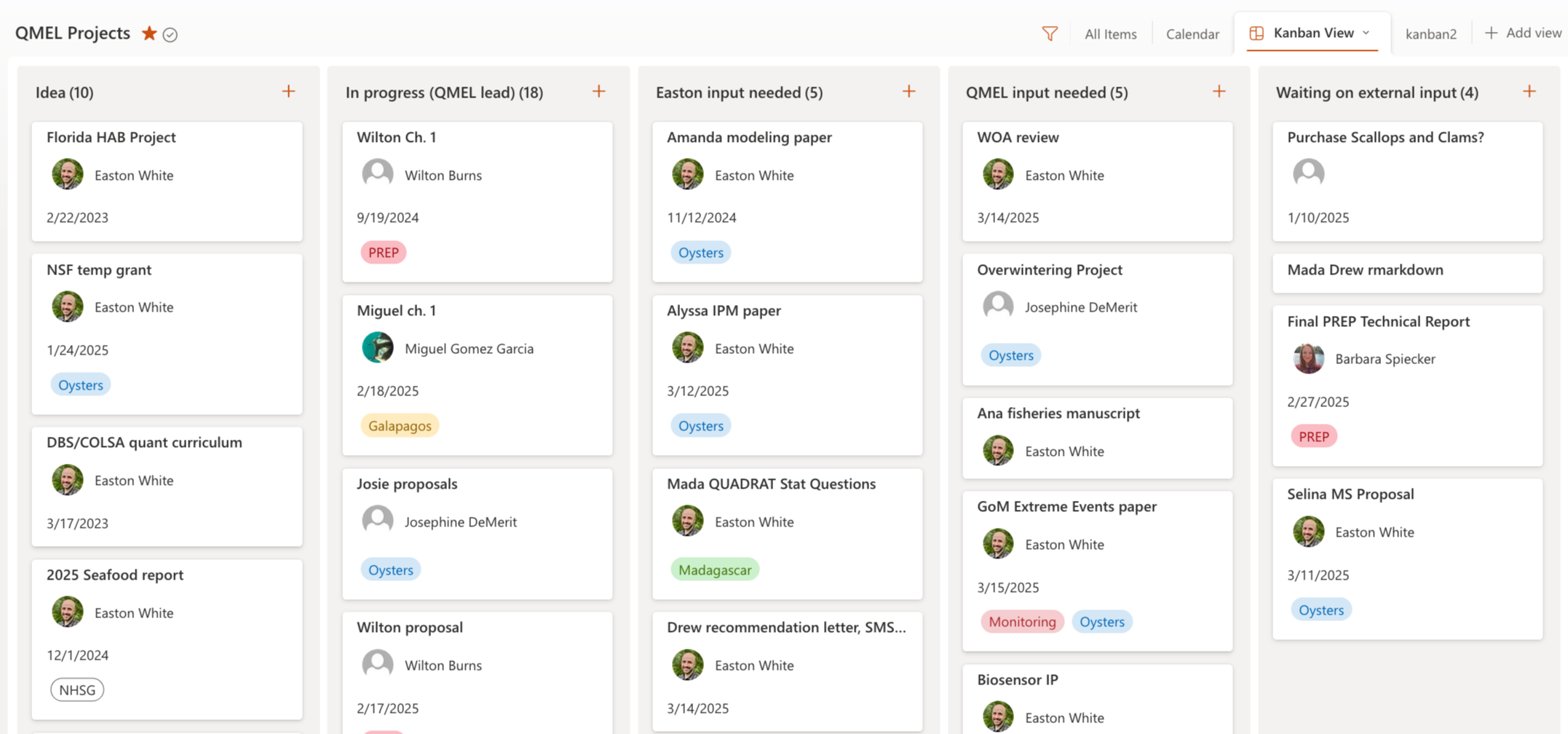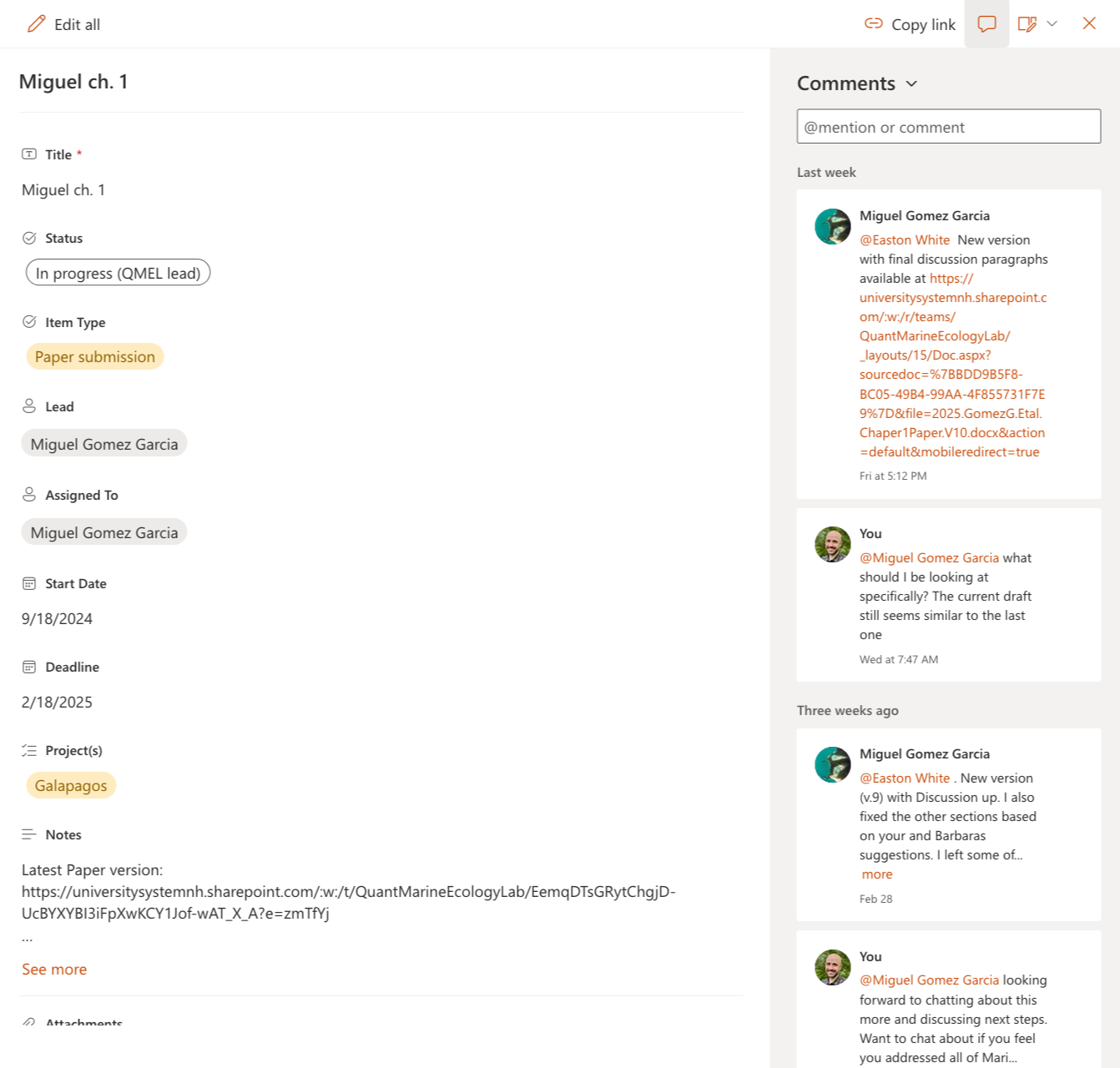3 Lab culture and philosophy
3.1 Guiding principles
There are several guiding principles that form the basis of my outlook as a scientist which also inform my approach to leading a lab. Throughout this lab manual, I will come back to these themes.
- Work-life balance
- Vulnerability and openness
- Transparency
- Tracking progress
- Antiracist principles
- Embrace failure - failing often is the key to success
- Celebrate and support one another
- Produce high quality science
- Communicate early and often
- Backwards design
- Produce science that can be used (stakeholder engagement, popular press)
3.2 General expectations
3.2.1 Big picture
Science can be hard, frustrating, and even sometimes painful (like when my appendix ruptured in the field!). However, the process of science can also be filled with joy, discovery, and collaboration. As a lab, it is key that we work together to create an environment that is conducive to productive, honest, and healthy science. We do not buy into myths that one has to work 80 hours a week or that you have to be cutthroat to succeed. With that in mind, there are a few big picture thoughts that are important for this lab (many of which are very different from other labs you may have been a part of):
- You should be working on problems that excite you. This doesn’t mean every step of the process will be exciting, but following your curiosity is a tried-and-true path to creating interesting and impactful science.
- We have to be very careful and honest about the science we produce. I am not a famous PI at some fancy school. When we produce groundbreaking or novel work, people will not take our word for it (and nor should they!). We have to be sure of the work we produce and own up to mistakes when they happen.
- Some of science is done on an individual business, but it is also highly collaborative. This is especially true in QMEL. When someone in the lab succeeds, we all succeed. Be kind and help one another.
- If you are struggling professionally or personally, it is important to seek help. This can be from Easton, your fellow lab mates, friends, family, or professionals. Easton sees a therapist frequently as a check on his mental health.
- A research lab is similar to a small business. As the lab PI, I am the entrepreneur and CEO. One of my main responsibilities is to provide overall direction and to bring in work (via grants). However, because we are a small group, there should be a relatively flat hierarchy in the lab. This research lab will only be successful if we work together.
- Research funding and publications are two commonly used metrics of success in science. This is problematic in many ways, but it is how things are. This doesn’t mean that we can’t work on other things (e.g., science outreach), but funding and publications still have to happen.
- Each semester, we will reflect as a group and in one-on-one discussions on upcoming goals of the lab. This is meant as a way to track our progress towards goals and reduce ambiguity. We are not aiming to accomplish 100% of our goals. Ideally, we will only accomplish 70-80% of our goals each semester to ensure our goals are achievable, but lofty. We also keep the idea of backwards design in our planning process on order to help us achieve our long-term goals.
- A critical part of being a lab member is attending events in the department, on campus, and beyond the university. Events can include casual coffee breaks, job candidate talks, scientific lectures, and social hours. All of these events provide an important opportunity for both your own career and to build a culture of community.
3.2.2 Small picture
- If you’re sick, stay home and take care of yourself. Because you need it, and also because others don’t need to get sick.
- You aren’t expected to come into lab on weekends and holidays, and you aren’t expected to stay late at night (Easton rarely works during these times). You are expected to get your work done (whatever time of day you like to do it).
- Show up and be on time for meetings.
- Keep the lab spaces clean and tidy
3.2.3 Taking time off
In order to maintain your mental health and productivity, it is essential to take time off. For this reason, all full-time lab members, including the PI, are guaranteed 20 paid days off. The lab PI appreciates when you let him know you won’t be in, but you are welcome to take time off for any reason. You don’t need to take time off for a scientific conference (related to your graduate work) or for holidays. There is no need to formally track your time off. There may also be days where your work isn’t going particularly well. You should feel empowered to leave work early and take care of yourself. In this lab, we are worried about long-term productivity versus how much time you spend on any given day doing work.
3.3 Communication
One of the most important aspects to being successful in this lab, UNH, and elsewhere is clear, early, and frequent communication. Early communication can save everyone a lot of headaches later on. We have several platforms for communication.
3.3.1 Weekly lab meetings
Each week, we will meet as an entire lab. At the beginning of each semester, we will decide on lab meeting objectives and goals. This can include topics like professional development, practice talks, reading and discussing papers, general check ins (including our mental health), or collaborative lab projects.
3.3.2 Weekly one-on-one meetings
The lab PI will meet weekly with each member of the lab unless a different agreement has been reached. I expect these meetings to be led by the advisee, not me. These weekly meetings are a way for you to keep me updated on your progress and to get input. I expect agendas going into each meeting and notes written afterwards in order to make our time together effective. This is your primary time to get my input on a regular basis.
3.3.3 Unscheduled communication
I am typically on campus from 9am-5pm Mon through Friday. However, my time is split between being working in my office, attending meetings, or teaching classes. When I am in my office, I may or not be available to chat. I often have “deep work” sessions where I am trying to concentrate and focus on thinking hard thoughts. During these times, or if I am on a call, my door will be closed. When my door is open, you are welcome to stop in for a quick chat. Anything longer than a few minutes may require setting up a formal time to chat.
3.4 Lab Slack team
The lab group uses Slack https://qmel.slack.com/ as one of our main communication tools. It is a useful way to celebrate our achievements together virtually, share interesting articles or papers, coordinate collaborations, and organize meetings. This helps remove some email clutter.
3.5 Email
We don’t use email a lot in the lab. We use email to collaborate with non-lab members or to share documents back and forth.
3.6 Texting and phone calls
I use texting and phone calls sparingly. They are best for quick one one-off messages (e.g., “For our meeting, let’s meet at the coffee shop instead”) or in case you really need something urgently (e.g., “I’m locked out of the building”). Conversations that require a lot of back and forth are often handled best in a quick in-person meeting.
3.7 Science workflow
Each scientist, lab, and field has their own set up favorite tools and technologies that allow them to actually do science. This ranges from what software to write papers to statistical software to field equipment. Below is a brief description of how the scientific workflow currently operates in the QMEL. A shared set of tools and approaches helps us ultimately make more progress as a group.
3.7.1 Programming (R, R markdown, and Github)
Our lab is a leader in open and reproducible science. This means that every member of the lab will use tools such as R, R markdown, and Github. These tools allow us to reproducible workflows and make our work more accessible to others. Where possible, each paper should be written in R markdown (and/or LaTex) and tracked using version control in Github. Sometimes this workflow is not possible given outside collaborators that may not be comfortable with these tools. Google docs can work as a substitute in these cases.
3.7.2 File storage and sharing
The lab primarily uses Sharepoint. We use Sharepoint for large file storage and backing up data. Sometimes, we use Google drive for collaborating on documents, especially with external co-authors. For manuscripts written by only members of QMEL, the preference for document preparation is a combination of R markdown (or Quarto) and Github.
When collecting new data (and also useful when downloading data from elsewhere), ensure you have several backups. There should be 1 copy on Sharepoint, 1 on your local machine, and 1 on an external drive.
3.7.3 Working on papers
The style of the lab is to share outlines and drafts of manuscripts early and often. This allows Easton or others to make comments early on in the process which might save a lot of headaches later. When you have a version, you would like Easton to read, simply let him know that you would like feedback and try to specify by when and for what you specifically want feedback with (e.g., structuring the introduction, figure design, etc.). Every grant and paper needs to be read by one other lab member and Easton before submission.
3.7.4 Reference manager
You are free to use whatever reference manager you prefer, but most people in the lab use Zotero. It is free, integrates with R markdown and Google docs, and allows collaborations among many people.
3.7.6 Lab website
An updated lab website (https://quantmarineecolab.github.io/) is important for public engagement and sharing our work with others. As a member of the lab, you are expected to contribute to the lab website from time to time. This includes a biography of yourself, project updates (usually in the form of blog posts), and posting papers. Details of how to contribute to the website are on the website’s Github page (https://github.com/quantmarineecolab).


3.7.5 Social media
The lab has a Twitter (https://twitter.com/quantmarineeco) that is maintained by the lab PI, but it hasn’t been used in a while.